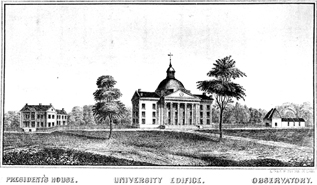
Lithograph Print of the University of Missouri Campus, ca. 1850
(University Archives, C:0/3/8)
Click on the image to see a larger version.
Historical Note:
The Geyer Act, the same legislation that brought the University into being, created the Board of Curators of the University of Missouri in February 1839. Under the provisions of this Act, the 10th Missouri General Assembly granted the Board, "power to sue and be sued, complain and defend in all courts of law and equity," it was also empowered to "make and use a common seal," and to, "take, purchase and hold, to sell, convey and otherwise dispose of lands and chattels" in the name of the University. Their duties included drafting for the University, "by-laws or ordinances, rules and regulations, as they shall judge most expedient." They were additionally given authority to appoint a President of the University "whenever they deem it expedient."
The number of Curators was set at fifteen to be elected by joint vote of the State Senate and House of Representatives, and to hold office for two-year terms. The first Board of Curators was chosen within days of passage of the Geyer Act, but did not meet as a group until October 10, 1839, as there was considerable difficulty gathering enough members to constitute a quorum. This first meeting was held in the city of Columbia, the University of Missouri's newly chosen home. At that time, Board officers were elected and a committee chosen to approach architects about initiating designs for a building to house the University's classes and administrative offices.
The rules for selection of Board members were changed in 1849, so as to allow a wider geographical representation. In this same measure, the number of Curators was increased to eighteen, with one to come from each of the fourteen judicial districts of the State and four to come from Boone County, in which the University is located.
By 1856 the University had become embroiled in the growing national debate over slavery. Divisions within the Board of Curators, and between its members and the University President, had become so intense that the offices of all Curators and of the President were declared vacant by the State General Assembly. Divisiveness was eliminated when Missouri's pro-slavery Governor used his emergency powers to re-appoint the University's pro-slavery President and give him a like-minded Board of Curators with which to work.
The Board faced, perhaps, its greatest challenge during Civil War years. In 1862, the Federal Government's provisional military Governor of Missouri ordered all Curators to take an oath of loyalty to the Union or their offices would be declared vacant. Only three of eighteen members chose to comply. With new Curators appointed, the Board met and, due to a disastrous financial situation, decided to suspend functions of the University. The institution remained inactive from March until October of 1862. Passage that same year of the Morrill Act by the national Congress did much to encourage the disheartened board members. The Act's allotments of Federal land for the support of higher education, plus resumption of payments from State revenues, put the University on sound financial footing once again.
In 1863, the General Assembly increased the number of Curators to twenty-two, requiring that two be from each of the State's nine congressional districts and the remaining four from Boone County. At this same time, much antagonism existed in the Assembly between factions desiring to use the Morrill Act revenues to create Colleges of Agriculture and "Mechanic Arts" at the existing University, and those who wished to found a separate institution which would be located in a more thoroughly loyal area of the State. This question was not finally decided until divided loyalties were no longer so important a consideration.
In 1870, the General Assembly voted to make the Colleges of Agriculture and Mechanic Arts part of the Columbia campus but, as part of a compromise, they also founded a School of Mines and Metallurgy in Rolla. This new institution was created as a part of the University of Missouri, under the authority of the existing Board of Curators. Its students and faculty were granted equal standing within the growing University System.
In the late 1870's, the Board's size was reduced twice: first to thirteen and then to nine members. It has remained at this far more manageable size since that time. These nine individuals are appointed by the Governor and confirmed by the State Senate. Their term of service is for six years.
A further expansion of the University System took place in the spring of 1963. At that time, the Trustees of the University of Kansas City transferred their institution to the University of Missouri. The School Board of the Normandy School District also transferred to the University of Missouri grounds and buildings of a former country club for use as a St Louis campus site. The Board of Curators has the authority to appoint Chancellors to have local control over the Kansas City, St Louis, Rolla, and Columbia campuses. A President of the University and the Board of Curators retain central authority for the entire system.
The University of Missouri Board of Curators has continued to preside over the day-to-day and year-to-year operation of the institution placed in its trust. The scope of its management responsibilities has grown as the University has grown: from one Campus to four and from a student body of dozens to one of tens of thousands.
Sources:
Olson, James C. Serving the University of Missouri: A Memoir of Campus and System Administration. Columbia: University of Missouri President, 1993.
Stephens, Frank F. A History of the University of Missouri. Columbia: University of Missouri President, 1962.
![]() Board of Curators Membership List
Board of Curators Membership List
Warning: This table is a large file (43kb)
